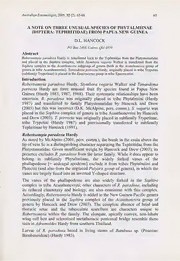
A note on three unusual species of Phytalmiinae (Diptera: Tephritidae) from Papua New Guinea PDF
Preview A note on three unusual species of Phytalmiinae (Diptera: Tephritidae) from Papua New Guinea
Australian Entomologist, 2005, 32 (2): 65-66 65 A NOTE ON THREE UNUSUAL SPECIES OF PHYTALMIINAE (DIPTERA: TEPHRITIDAE) FROM PAPUA NEW GUINEA D.L. HANCOCK PO Box 2464, Cairns, Qld 4870 Abstract Robertsomyia paradoxa Hardy is transferred back to the Tephritidae from the Platystomatidae and placed in the Sophira complex, while Stymbara vagaria Walker is transferred from the Sophira complex to the Acanthonevra subgroup of genera (both in the Acanthonevra group of genera in tribe Acanthonevrini). Tanaodema porrecta Hardy, originally placed in tribe Trypetini (subfamily Trypetinae) is placed in the Epacrocerus group in tribe Epacrocerini. Introduction Robertsomyia paradoxa Hardy, Stymbara vagaria Walker and Tanaodema porrecta Hardy are three unusual fruit fly species found in Papua New Guinea (Hardy 1983, 1987, 1988). Their systematic relationships have been uncertain. R. paradoxa was originally placed in tribe Phytalmiini (Hardy 1987) and transferred to family Platystomatidae by Hancock and Drew (2003) but this was incorrect (D.K. McAlpine, pers. comm.). S. vagaria was placed in the Sophira complex of genera in tribe Acanthonevrini by Hancock and Drew (2003). T. porrecta was originally placed in subfamily Trypetinae, tribe Trypetini (Hardy 1987) and provisionally transferred to subfamily Tephritinae by Hancock (1991). Robertsomyia paradoxa Hardy As noted by McAlpine (2001, pers. comm.), the break in the costa above the tip of vein Sc is a distinguishing character separating the Tephritidae from the Platystomatidae. Given insufficient weight by Hancock and Drew (2003), its presence excludes R. paradoxa from the latter family. While it does appear to belong in subfamily Phytalmiinae, the widely forked vanes of the phallapodeme [= aedeagal apodeme] exclude it from tribes Phytalmiini and Phascini (and also from the unplaced Polyara group of genera), in which the vanes are largely fused into an inverted Y-shaped structure. The vanes of the phallapodeme are also widely forked in the Sophira complex in tribe Acanthonevrini; other characters of R. paradoxa, including its reduced chaetotaxy and biology, are also consistent with this complex. Accordingly, Robertsomyia Hardy is added to the New Guinea-Pacific genera previously placed in the Sophira complex of the Acanthonevra group of genera by Hancock and Drew (2003). The complete absence of head and thoracic setae and the tuberculate scutellum are characters unique to Robertsomyia within the family. The elongate, apically convex, non-lobate wing cell bcu and sclerotised metathoracic postcoxal bridge resemble those seen in Adramoides Hardy from southern Thailand. Larvae of R. paradoxa breed in living stems of Bambusa sp. (Poaceae: Bambusoideae) (Hardy 1983). 66 Australian Entomologist, 2005, 32 (2) Stymbara vagaria Walker The presence of some yellow setae on the head, the wrinkled preglans area of the distiphallus and the shape of the phallapodeme, hypandrium, epandrium and surstylus (Hardy 1988) clearly ally Stymbara Walker with Cribrorioxa Hering, Ectopomyia Hardy, Hexacinia Hendel and Rioxa Walker in the Acanthonevra subgroup of genera, to which it is transferred. Tanaodema porrecta Hardy The presence of a break in the costa above the tip of vein Sc and a distinct katepisternal seta (D.K. McAlpine, pers. comm.) confirm the placement of T. porrecta in the Tephritidae. The shape of both the face and the antenna, with its second segment expanded on its inner margin, suggest a relationship with the Epacrocerus group of genera (tribe Epacrocerini) (Hardy 1987, D.K. McAlpine, pers. comm.), in which some genera also show a peculiarly modified head, although to a much lesser extent (Hardy 1982). The presence of a blunt apex to wing cell bcu and the placement of the dorsocentral setae anterior to the line of the supra-alar setae support this suggestion. Tanaodema Hardy is therefore added to the genera placed in tribe Epacrocerini by Hancock and Drew (2003). It is characterised by a remarkably elongate head with no frontal setae, 2 pairs of orbital setae and the eye situated medially, porrect antennae with the second and third segments almost circular in shape and the arista almost bare, 2 scutellar setae and narrow wings with no distinct costal seta above the tip of vein Sc and a narrow, elongate pterostigma. Acknowledgement j I am grateful to David McAlpine (Australian Museum, Sydney) for his perceptive comments on an earlier draft of this paper. References HANCOCK, D.L. 1991. Revised tribal classification of various genera of Trypetinae and Ceratitinae, and the description of a new species of Taomyia Bezzi (Diptera: Tephritidae). Journal of the Entomological Society of Southern Africa 54(2): 121-128. HANCOCK, D.L. and DREW, R.A.I. 2003. New species and records of Phytalmiinae (Diptera: Tephritidae) from Australia and the South Pacific. Australian Entomologist 30(2): 65-78. HARDY, D.E. 1982. The Epacrocerus complex of genera in New Guinea (Diptera: Tephritidae: Acanthonevrini). Memoirs of the Entomological Society of Washington 10: 78-92. HARDY, D.E. 1983. Robertsomyia an aberrant new genus of Phytalmiini from Papua New Guinea (Tephritidae: Diptera). Proceedings of the Hawaiian Entomological Society 24: 227-231. HARDY, D.E. 1987. The Trypetini, Aciurini and Ceratitini of Indonesia, New Guinea and adjacent islands of the Bismarcks and Solomons (Diptera: Tephritidae: Trypetinae). Entomography 5: 247-373. HARDY, D.E. 1988. Fruit flies of the subtribe Gastrozonina of Indonesia, New Guinea and the Bismarck and Solomon Islands (Diptera, Tephritidae, Trypetinae, Acanthonevrini). Zoologica Scripta 17: 77-121, McALPINE, D.K. 2001. Review of Australasian genera of signal flies (Diptera: Platystomatidae). Records of the Australian Museum 53(2): 113-199.
